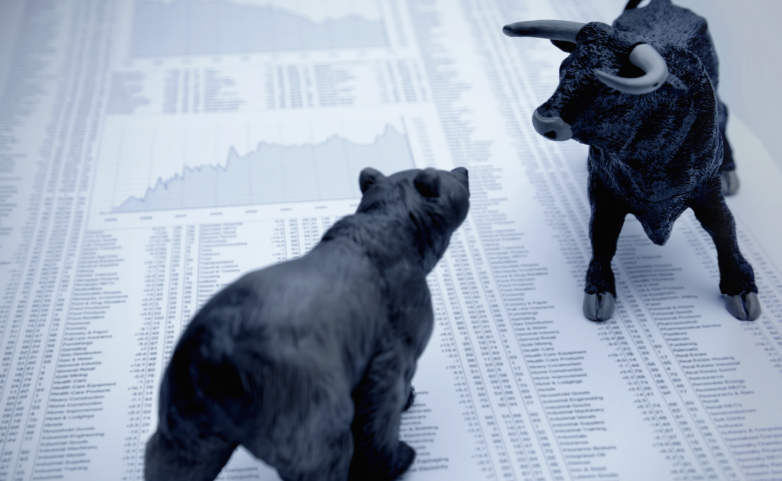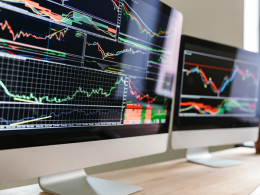One month ago, we wrote an article laying out i) what we thought was the most important correlation in the market, namely that between the 10Y yield and the S&P500, and also ii) explaining why in the aftermath of the February 5 vol explosion, it had flipped.
Specifically, we said that "the 90-day correlation between stock (SPY) and bond (TLT) markets has surged ominously in the last few weeks."
Today, none other than fixed income derivatives trading legend, Harley Bassman, picks up on this especially relevant topic, to explain why it really is all about the correlation.
For those who may be unfamiliar, after building out Merrill's mortgage trading floor basically from scratch, then moving to the buyside at Pimco, last summer Harley Bassman, more familiar to many traders as the "Convexity Maven" - a legend in the realm of derivatives - he designed the MOVE Index, better known as the VIX for government bonds - decided to retire (roughly one year after his shocking suggestion that the Fed should devalue the dollar by buying gold).
But that did not mean he would stop writing, and just a few months after explaining why "a decline of as little as 4% in one day could start a critical crash", a prediction which was confirmed by last month's volocaust, today Bassman provides the answer to a question which virtually every trader is asking: when should one worry, and when will the real bear market start?
While the full - and detailed answer is provided in the full report below - his summarized answer, "for the record", is that "the real bear market will start once the long-term correlation between stocks and bonds flips for good."
As he explains, the reasons for this correlation quake are manifold, but would likely involve ten-year Treasuries rising above 3.25%. Such would require a domino effect of the Fed raising rates three or four times, which of course would be precipitated by rising inflationary expectations.
He also points out that there is a risk of a "friendly fire" scenario "of inadvertently stumbling into a Trade War, which is suddenly no longer a Black Swan event. While China cannot reduce its Treasury holdings without elevating its own currency, it certainly could threaten to sell Treasuries. Since provocative political bluster is now de rigueur, a few tweets from the Bank of China could be quite effective."
And while we would go a little further, and say that one should keep a close eye on the USD and funding markets, the current state of the tech bubble, vol gamma, the Libor-OIS, the 10Y yield, and of course, overall market liquidity, which as Goldman yesterday finally admitted is "the new leverage", we fully agree that perhaps the most important "reversal" indicator would be the bond-stock correlation, and specifically the moment when it no longer reverts.
Bassman's full thoughts below (pdf link):
“How will I know…..”
Last summer, in “Rambling near the Edge” (July 10, 2017), I highlighted that a combination of Risk Parity and Volatility Targeting strategies had contributed to a negatively convex market profile; and that such portfolios governed by a rules-based risk management process (similar to a Value at Risk – VAR paradigm) could become quite unstable in a slightly more volatile environment.
An extension of this observation led me to suggest that one could synthetically model this risk profile as long an Index portfolio plus short a +/- 4% out-of-the-money strangle (on the Index). Thus, the quotable notion that as little as a 4% decline of the SPX in a single day could be enough to create the critical mass needed to shake portfolio managers out of their FED-induced somnambulance.
I suppose better lucky than smart……….
I doubt you need reminding, but on February 2nd the SPX closed down 2.1%, which elevated the VIX from 13.5 to 17.3; a level last visited in August 2017 and still well below its ‘forever average’ of 19.3.
The next day, February 5th, as shown below, the SPX experienced a late day tumble that clipped down 4.5% from the prior close before the bell rang to record a 4.1% daily decline.
The VIX crossed 20 soon after lunch, and closed the day at 37.3, up 116%. Portfolio managers governed by tight stops or reliant upon short-term signals had to close out positions as the VIX breached 50 (overnight) for only the second time since the Lehman collapse.
The jump in the VIX, and the schadenfreude-laced news that the best investment strategy of 2017 (XIV) collapsed by 95% overnight, has been well documented by the press and other pundits. What has not been detailed are the contributing factors and what may presage a much greater drawdown.
Expanding upon a notion detailed on page 6 of “It’s Never Different This Time” (January 29, 2018), the level of Implied Volatility is important for quantitative portfolio management as more than just a scalar measure of risk, i.e., VIX as the infamous “Fear Gauge”. Implied Volatility also generates the Greeks (delta, gamma, theta and vega) that define trading parameters and trigger stop-outs. Hence, unanticipated market movements can force indiscriminant hedging activity as risk managers suddenly outrank their CIOs.
Whipping out a pen from my plastic pocket protector, an (annual) Implied Volatility of 19.3% (the VIX average) can statistically be reduced to a single-day standard deviation (often called the daily breakeven) of 1.21%. [19.3 / 15.9 =
1.21; where 15.9 = square root of 252 trading days]
The line below is the VIX for the prior year, which averaged about 11.25. Playing a bit fast and loose with Stat 101, this would impute a daily volatility of 0.71%. That makes the 4.1% close-to-close change on February 5th a 5.78-Sigma event (4.1 / 0.71), which should occur about once every 2 million years. A fairer proposition would be to use the VIX close on February 2nd of 17.3. By that measure, the February 5th drawdown was a mere 4-Sigma event, which should only occur once every 31,560 days, or 126 years.
My purpose here is to highlight how totally unprepared much of the investment community was for what in hindsight was a rather pedestrian correction. After an extended period of low (but not unprecedented) volatility, many risk models dialed-down such that an annual July 4th fireworks display suddenly was treated like a once-in-a-lifetime visit from Halley’s comet. In the more common environment of the VIX at 21, a 4% move would be expected to occur about once every three years, which sounds about right.
The point of this rather long preamble is to explain how quantitative investment management can be problematic. Specifically, strategies that rely upon short-term signals and have narrow loss limits can be forced to transact at unfavorable times; thus were many managers shaken out of otherwise fine investments.
I believe the main reason February’s convulsion was relatively contained, with almost a full recovery of the SPX and a return of the VIX to a more normal 17ish, is that ‘short-signal’ managers control only a relatively small portion of investment capital. The ‘big money’ tends to make decisions using longer observation periods to reduce both the statistical noise as well at the transaction costs associated with increased activity. Hence, there is no need for position adjustments until there is a more sustained decline.
Let’s segue to the topic at hand. Among the most successful macro portfolio managers have been those engaged in the Risk Parity strategy. Using a broad brush, a Risk Parity portfolio owns both stocks and bonds in statistical proportion to their volatility and correlation. The trick is that, instead of a standard unlevered 60/40 construct (60% equity + 40% bonds), leverage is employed to take advantage of the relationship between these two assets.
For example, an ordinary passive investment portfolio of $100 might buy $60 of the SPX and $40 of US 30-year bonds. Alternatively, a Risk Parity portfolio of $100 might own $70 of SPX and $130 of bonds. On its face, this may seem imprudent since $200 of assets have been purchased with only $100 of capital; but in fact, this sort of portfolio has proved less volatile over the recent past.
This is because stocks and bonds have exhibited a significant negative performance correlation over the past decade. (Well, actually they are positively correlated when measuring changes in the SPX’s price and the Bond’s yield.)
Above is the three-month moving average of the three-month correlation between the SPX price change and the Sw30yr yield change. What is most salient to note is how this correlation was close to zero in the decade prior to the Great Financial Crisis (GFC) but has since clocked in near 40%.
There are two common explanations for this shift to a stronger correlation. The first postulates that this is the result of the heavy hand of Financial Repression. The obvious support for this notion is the lurch to correlation soon after the start of Quantitative Easing (QE) by the Fed.
The alternative explanation is that the stock-to-bond correlation has been observed to be well associated with the level of Inflation. During times of low inflation, a rate decline can signal economic weakness, which is negative for stocks (bonds prices up / stock price down - positive correlation). However, at times of higher inflation, rising rates would presage a Fed tightening of monetary policy, which could pressure equities lower (bond prices down / stock prices down - negative correlation).
While it is possible that the presently elevated positive correlation could be related to a low and steady CPI, it is unquestionable that QE is a direct result of low inflation. Its purpose was to raise Inflation to the Fed’s target level.
Notwithstanding the above, I see no reason to untangle the chicken from the egg; QE will revert to QT (Quantitative Tightening) as inflation begins to rise.
Thus, we arrive at a truly strange anomaly, the result of a well-intentioned public policy that seems to have inadvertently contributed to our disruptive politics.
As noted, since the GFC in 2008-09 there has been a high correlation between the daily changes in stock prices and bond yields – when stock prices go up, bond prices go down, and vice versa. As such, one should suspect that if stock prices are near a record high, bond prices might be approaching some sort of nadir. Instead, both asset classes are near the upper edge of a decade’s performance.
This is possible because of the different time periods used to measure correlation. On a daily basis these assets have been self-hedging as they have wiggled in opposite directions as buffeted by the news of the day. But over the longer-term horizon, they have both been elevated via Central Bank monetary expansion; a key contributor to rising income inequality.
Risk Parity’s tremendous success is revealed via the SPX price in the chart above and the price of a constant 30-year treasury bond. Risk Parity portfolios have been ‘levered long’ assets that have both increased in value. (We used to call this a Texas-hedge.) Here is the bottom line: If this correlation turns negative so that both stock and bond prices decline, Risk Parity portfolios will be modified to reflect these new correlations and volatilities. In simple terms, they will sell. Risk Parity portfolios will not remain levered long if both assets are declining.
So you want to know when to worry ?
For the record: The real bear market will start once this correlation flips.
Reasons this could occur are manifold, but it likely would involve ten-year Treasuries rising above 3.25%. Such would require a domino effect of the Fed raising rates three or four times, which of course would be precipitated by rising inflationary expectations.
Of course, there is also the ‘friendly fire’ scenario of inadvertently stumbling into a Trade War, which is suddenly no longer a Black Swan event. While China cannot reduce its Treasury holdings without elevating its own currency, it certainly could threaten to sell Treasuries. Since provocative political bluster is now de rigueur, a few tweets from the Bank of China could be quite effective.
Your comments are always welcome at: harley@bassman.net
Harley S. Bassman
March 19, 2018





















